
|
|
|
|
|
Jack the Lizard is on YouTube |
Rock in Dino Stomach
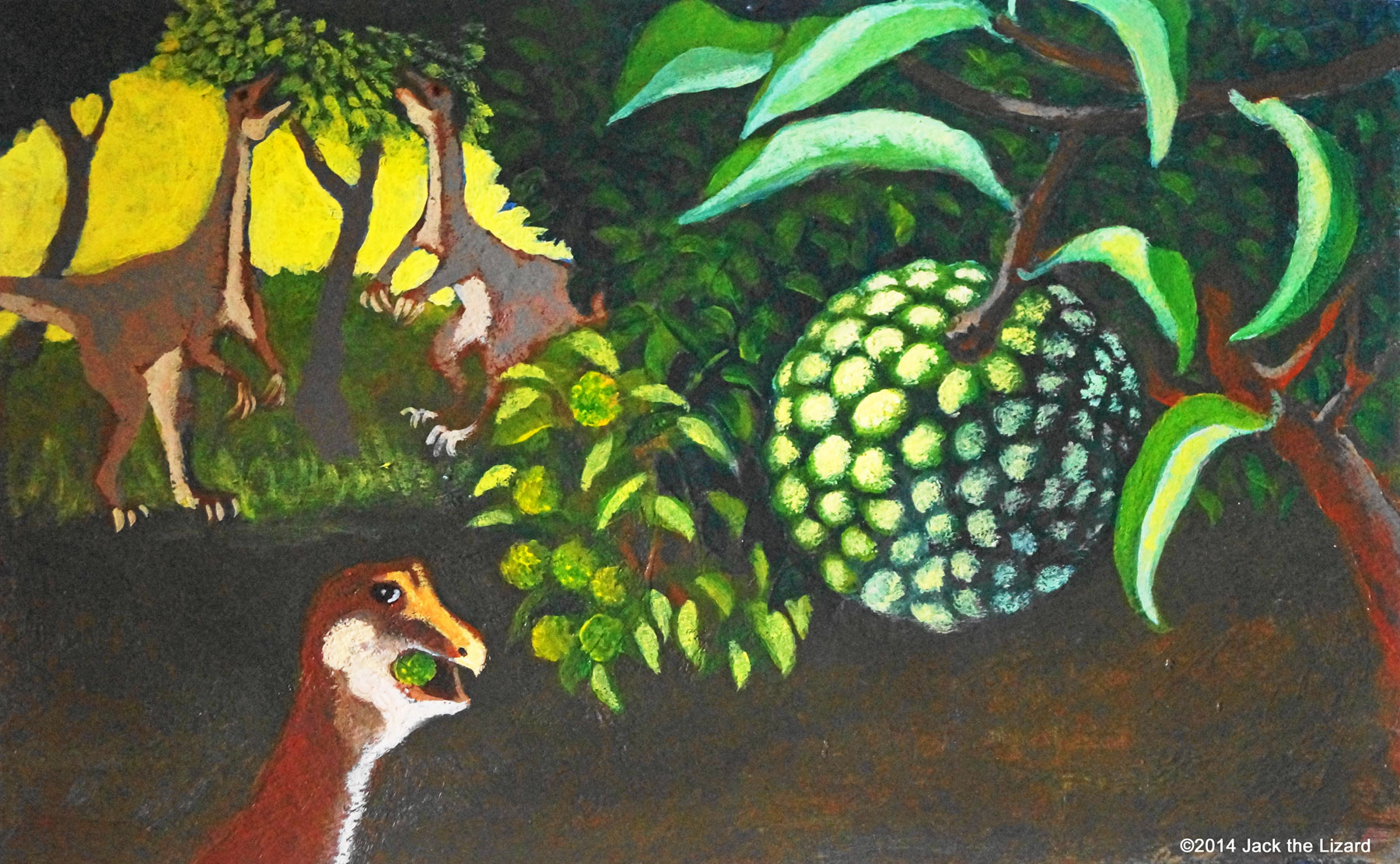
|
|
Ornithomimids were bipedal theropoda living from the Early to the Late cretaceous Period. They probably ate fruits, seeds, and small animals such as crustaceans and lizards. Many of their fossils included gastroliths, also called stomach rocks, which usually helped stomach to break down hard plant material such as leaves and twigs.Ornithomimids might have had the cheek pouches to store foods which later chewed more with teeth. Some of them also had large bellies which contained long digestive system to ferment and digest. Gastroliths were also found in the stomach of sauropods such as titanosaurs and used to dissolve foods. Sauropods with small teeth perhaps could not chew foods well and had huge intestines in which some microorganisms live and breakdown hard material such as cellulose. On the other hand carnivorous dinosaurs did not have gastroliths in their stomach and their bellies were relatively small. Since meat was easily dissolved in the stomach, most of meat eating dinosaurs swallowed meats without chewing. However the bones were hard to digest and absorb, then occasionally found in the coprolites of carnivorous dinosaurs. Gastroliths are very interesting material to discuss and also the connection between the shape of teeth and what dinosaurs ate is important. Also living animals such as crocodilia and birds have gastroliths. |
The Longevity of Dinosaurs
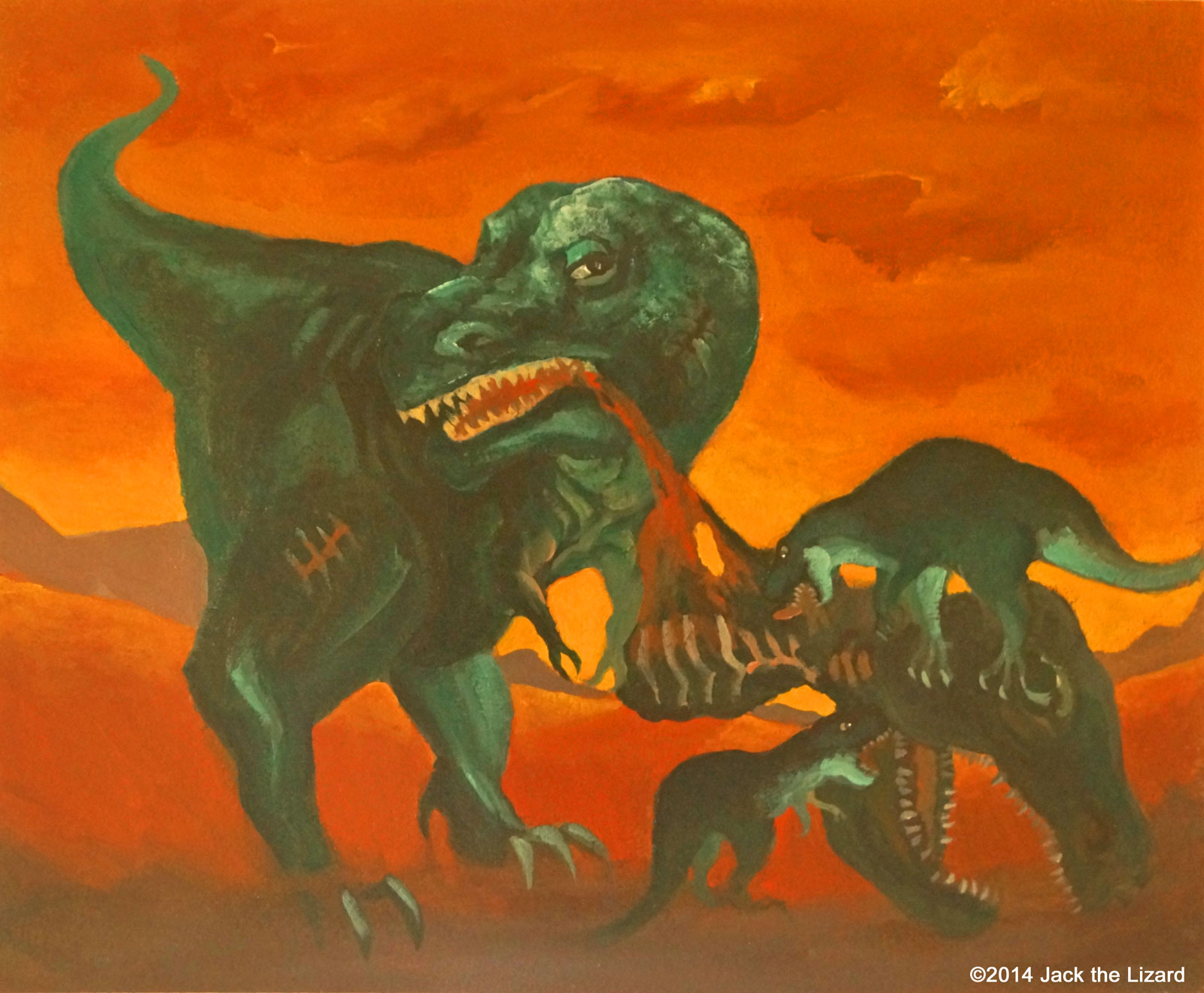
|
|
Although the lifespan of dinosaurs are still open to debate, several estimations are made on some species. The lifespan of animal often depends on their body size and metabolism. Usually modern reptiles live longer than mammals living now, because their metabolism is slower than mammals’. As matter of fact there is the record that the giant tortoise lived for over 150 years. Crocodiles and alligators can surpass 60 to 70 years old. Even some birds such as parrots and cockatoos can live for over 70 years. Slow metabolism means that cold—blooded reptiles do not have to intake food all the time, unlike mammals that have warm blood and must eat food and drink water to keep their body temperature steady. So the lifespan of dinosaurs comes to whether dinosaurs were cold— blooded or not. If they were, gigantic sauropods such as Apatosaurus would live over 300 years and also large theropoda such as Allosaurus might survive for 60 years. However smaller size dinosaurs both herbivores and carnivores would have short term longevity. So Deinonychus would have difficulty to reach 20 years old. Examining the bones is another way to estimate the age because the bones of mammals and birds often shows continuous growth rate whereas reptiles grow their bone periodically. Unfortunately this theory cannot apply to dinosaurs as the bones of dinosaurs have both features. Nevertheless all animals have harsh life in the wild. Dinosaurs were not exception. For instance the lifespan of Tyrannosaurs is estimated for 40 years, but probably most of them could not make that long life. Although Tyrannosaurus was the one of the strongest predator of their time, they probably had threats from their own, just like lions do today. Not only Tyrannosaurus had hard life but also the other dinosaurs would have difficult life because of diseases, injuries, predation, and natural disasters. |
Horses Born to Run
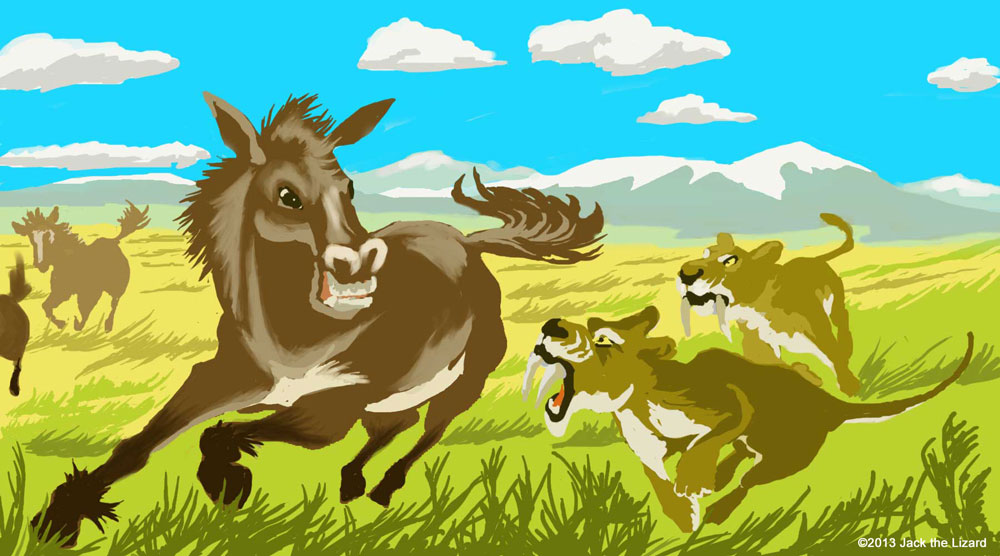
|
|
Odd-toed ungulates include horses, tapirs and rhinoceros, all of them has hooves with an odd number of toes. Their common ancestor evolved around 55 million years ago in Asia. Then horses and tapirs evolved in North America and rhinoceros had diversified in Asia. Eohippus was the earliest known animal that had features of horses. This fox-sized animal lived in North America around 52 million years ago. Unlike modern horses they dwelled in forests and ate leaves off tree. As the climate had been changed in North America glass land extended. Animals had adapted to this environment. The legs had been getting long and the number of toes was reduced. The teeth were also getting long to eat hard grasses. The change of body plan made animals run fast in open area to escape from predator. Mesohippus had developed those features and widely spread in North America about 40 million years ago. Pliohippus was animal who lived in the middle Miocene around 12 million years ago. They had many similarities of modern horses. Unfortunately global cooling drove many mammals, including horses, in North America into extinction at the end of the Pleistocene. Humans might have contributed to their extinction as well. Przewalski’s horse is the last wild horse on the Earth now. |
Fungus Kingdom

|
|
Fungi had started dwelling on the land during the Cambrian Period, around 500 million years ago, before even plants had. Since then fungi have thrived on the land and survived even five mass extinctions. The least mass extinction called "Cretaceous-Paleogene extinction event" had probably occurred when the huge asteroid had hit the Earth at the end of Late Cretaceous Period. After the impulse of the asteroid dusts and clouds had covered surface of the Earth and sunlight reaching the land would had been limited. Consequentially most photosynthetic plants had died and all dinosaurs both herbivores and carnivores gradually died out along with them. Few survivors were left including small mammals and fungi. Fungi do not need much sunlight and prefer high humidity. After Cretaceous-Paleogene extinction the Earth became ideal habitat for fungi and they were dominant species over dinosaurs on the land at least brief period of the time. Even now the oldest and largest living organism on the Earth is the fungus which has been living since ice age, around 10,000 years ago and expands more than 30 acres in the ground of the state of Michigan and Wisconsin. |
Jurassic Riparian Forest
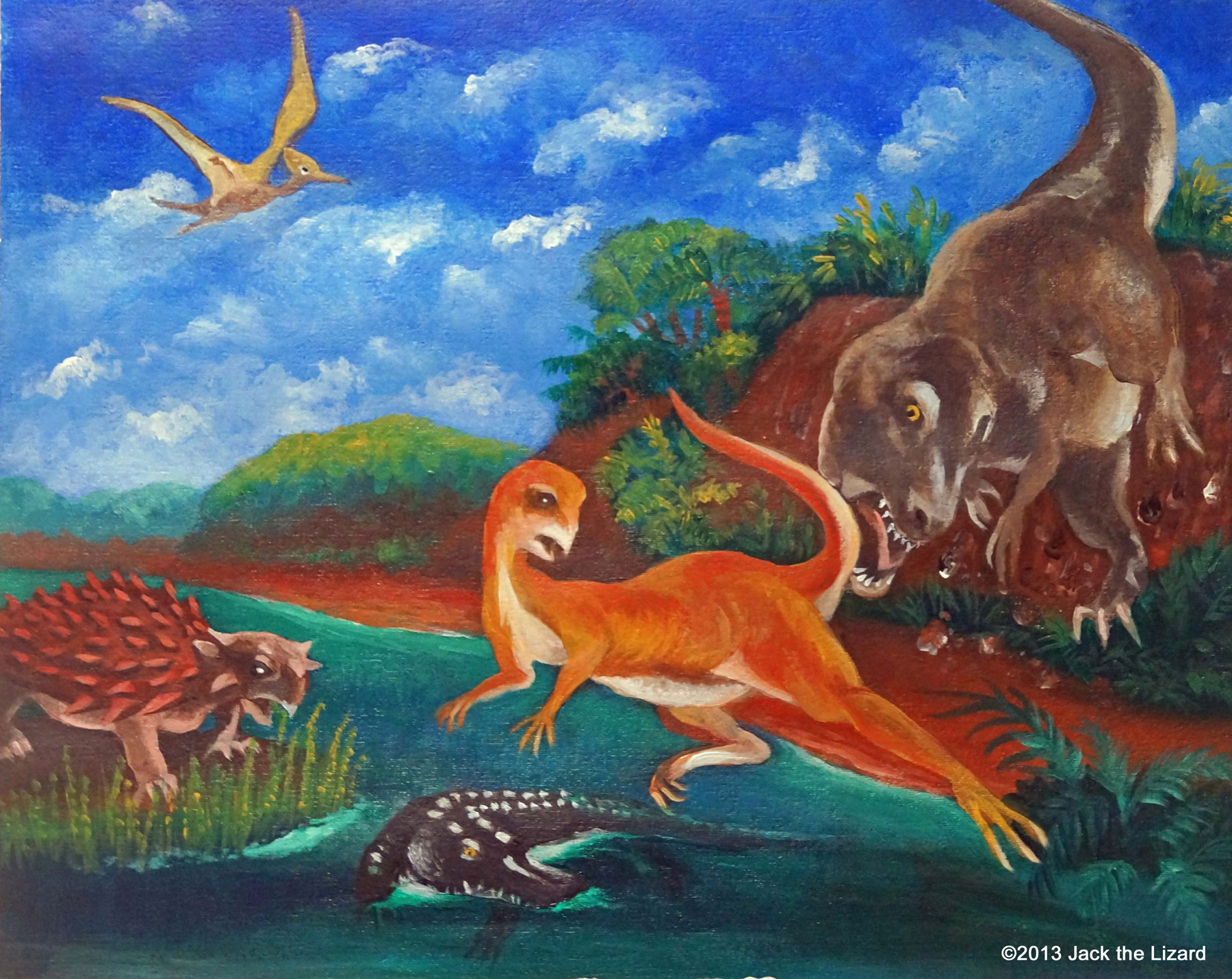
|
|
Rivers always sustain the life on the land. During the Late Jurassic Period even dinosaurs inhabited at a river side. The forests along the rivers are called riparian forests. There were riparian forests during the Late Jurassic as well. However large cycads and ferns were probably the dominant plants along the rivers at this time. Herbivorous dinosaurs such as Dryosaurus and Gargoyleosaurus probably forage for vegetation at a riparian forest and carnivorous dinosaurs preyed on those. Similar ecosystem is occurred in Africa now. Wildebeests and antelopes are gathering at a river side to eat and drink while lions and leopards hunt them from ground and crocodiles are hiding under water to assault. While Allosaurus were chasing Dryosaurus, Harpactognathus flying over a river aimed at fish. Many birds of prey come to river for hunting and scavenging in Africa as well. Amazingly crocodiles had already existed during the Late Jurassic and they are still living. |
Prairie Dinosaur
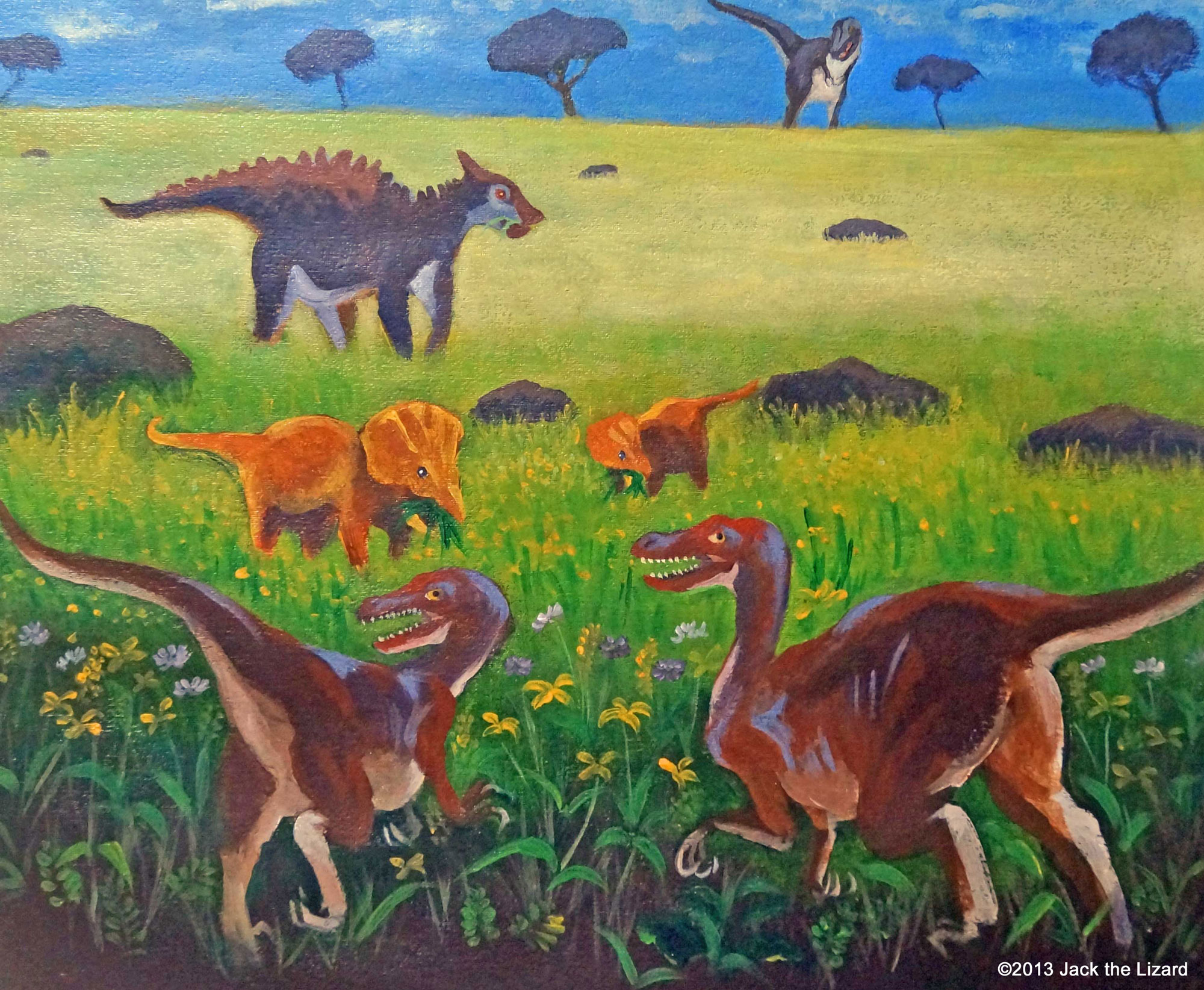
|
|
|
In the Late Cretaceous Period the Earth was much warmer than today. The location of the continents was similar to now, but still it was not exactly same and the current of the ocean was also different. Probably those factors affect the climate during the Late Cretaceous Period. For example the Gobi Desert in Mongolia was prairie instead of desert at that time. Predator such as the family of troodon probably hunts protoceratops as lions do impala today. Since numerous fossils of plant―eating dinosaurs are discovered, there were probably enough water source to plants to thrive in those days. Even large herbivorous dinosaurs such as the family of hadrosaurs inhabited there. Large prey means that large predator such as tarbosaurus which belong to the family of tyrannosaurs could prey upon them.
Some animals such as beavers and humans are able to change the environment surrounding them by building structures and sometimes cause serious impacts such as deforesting on nature. Especially humans are expanding deserts by agriculture and irrigation on the Earth now. However dinosaurs probably neither did nor could change the nature and that might be the reason they survived so long. |
Reptile Story
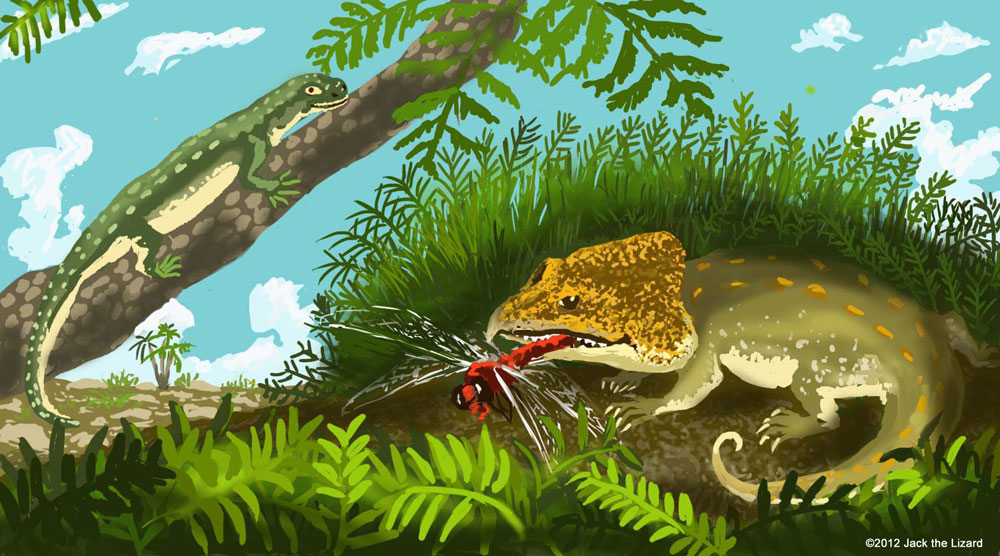
|
|
Origin of reptile is unknown. However the earliest reptiles such as Hylonomus and cephalerpeton are all lizard-like reptile. Those earliest reptiles lived from the Late Carboniferous to the Early Permian Periods. Later they split into two important lines of land living vertebrates. One was mammal-like reptile “Synapsida” from which mammals evolved and the other was Cotylosauria. Cotylosaurs are, also called stem reptiles, the ancestors of all other reptiles including dinosaurs, birds and living reptiles. They emerged from the Carboniferous Period and disappeared during the Triassic Period. Labidosaurus belongs to Cotylosaurs family. The fossils of Labidosaurus which lived during the Early Permian Period were discovered in Texas. The size was probably 30 inch (75cm) long. Inferring from its teeth Labidosaurus was probably omnivore, eating plants and invertebrates such as insects. Procaptorhinus lived somewhat earlier than Labidosaurus and might be direct ancestor of Labidosaurus. |
Germ attacks Dino
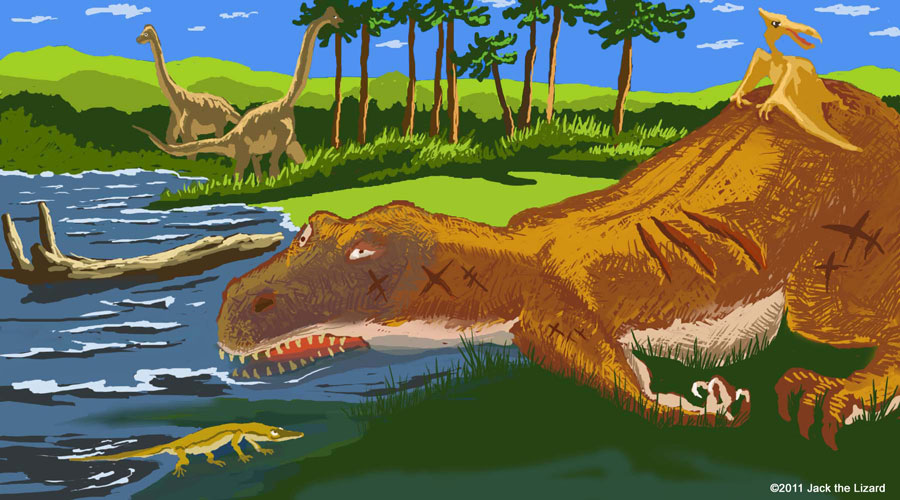
|
|
|
Did dinosaurs get sick? Probably, Yes. Virus and bacteria cause illness such as flu and tuberculosis. Protozoan also causes illness. For instance plasmodium is the protozoan which is source of malaria. During the dinosaur era from the Triassic to the Cretaceous period perhaps those germs existed. Although the direct evidence is unlikely found now, their existence could be inferable.
Some dinosaurs are similar to birds. If birds of prey such as eagles and owls have some parasite inside them, they will develop holes around their lower jaws. Then same types of holes have been found in the lower jaws of some specimen of Tyrannosaurus. Insects trapped inside amber since dinosaur era may have good proof too. Those insects carried parasites such as Leishmania which cause skin diseases and fever. Although reptiles usually get fewer diseases than warm-blooded animals, that parasite could infect reptiles, and some dinosaurs are closed to reptiles. Also dinosaur dung with parasite such as Nematode has been found. Dinosaurs with that parasite might have arthritis. |
|
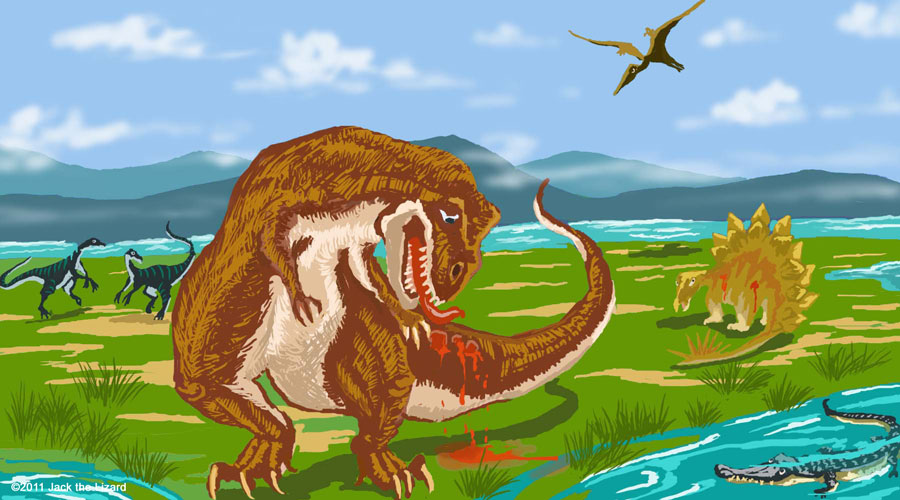
|
|
Everyday InjuriesSome Allosaurus and Triceratops have bone over growth. Probably result of injuries led this irregular growth. One Albertsaurus also has recovered bone from fracture. Aging DinoAs Dinosaurs was getting old, probably they got some probably in their bodies. For instance some Iguanodons had degenerated joint disease on their ankles. |
Jurassic Predators
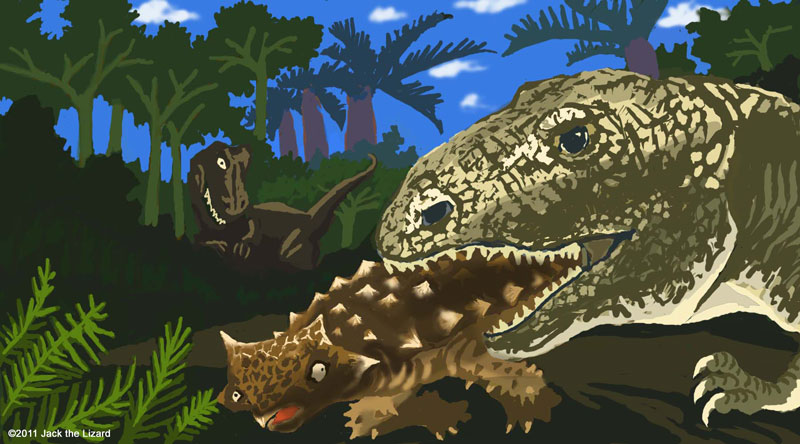
|
|
In the Late Jurassic period Tyrannosaurus had not appeared yet, but large meat eating dinosaur groups such as Allosauridae and Megalosauridae had already emerged. Torvosaurus was the one of the largest carnivorous dinosaurs during the Late Jurassic period. The size is about 12m (40ft) in length and the weight is around 30 tons. The fossils were found in Colorado, U.S.A. and Portugal. Epanterias was another large carnivore in the Late Jurassic period, and the fossils were also found in Colorado. Saurophaganax was even larger predator, about 13m (41ft) in length, found in Oklahoma. Those predatory dinosaurs including Allosaurus might compete for prey such as Stegosaurus and Mymoorapelta (a genus of Akylosauria). Even large sauropods dinosaurs such as Camarasurus, Brachiosaurus, and Apatosaurus could have fallen prey to them. |
Back off - Giant Beaver -
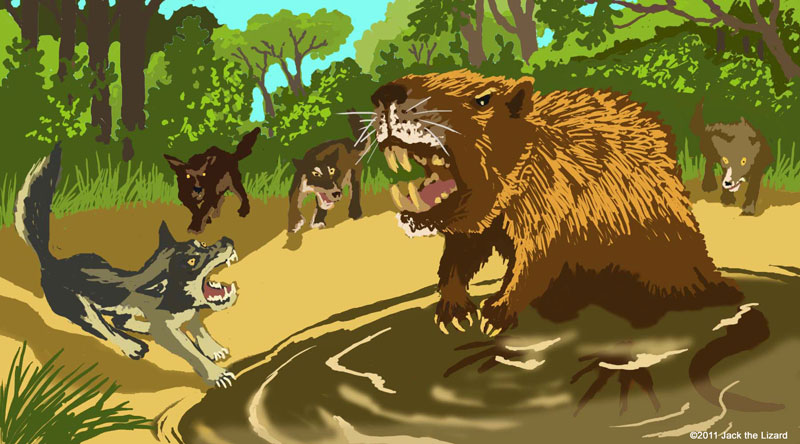
|
|
The Giant beaver had black bear size body. The size was about 2.5m (8.2ft) and weight was approximately 60 to 100kg (130 to 220lb), some might go over 180kg( 400lb) . Until now two species of giant beavers were found, one lived in all over North America and another was in southeast United States, both of them exited 2.1 million to 11000 years ago. The teeth were about 15cm (6in) long, from the shape of teeth giant beavers probably ate plants. The habitats were ponds and rivers, similar to modern beavers and they might build the lodge too. Despite likeness of body feature giant beavers do not closely related to modern beavers. Unlike modern beavers, Giant beavers did not have many threatening predators because of their size. Even pack of dire wolf could not take it down so easily. |
Elephant size bear - Arctotherium Angustiden -
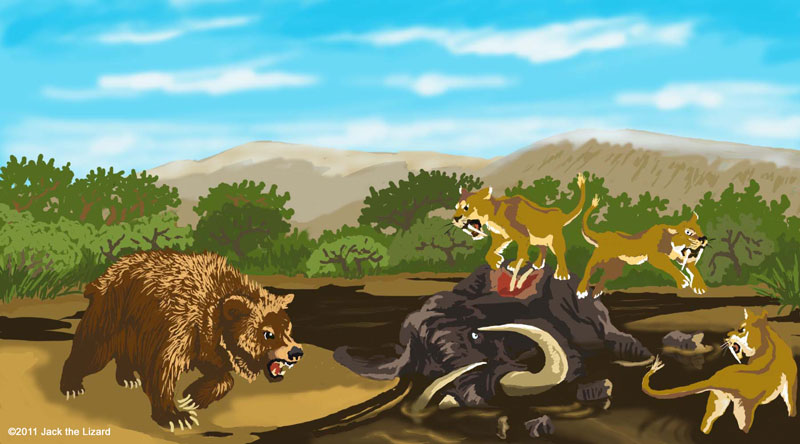
|
|
Arctotherium angustiden is a member of Arctotherium group which includes five species. Arctotherium is also called “the South American giant short-faced bear” because of that enormous size, about 3.4m (11ft) long and up to 1600kg (3500lb) in weight. The forearm bone of this bear is about same size of an elephant’s. Arctotherium angustiden lived in South America approximately from 2million to 500,000 years ago. Although they would have been omnivore like a modern grizzly, they must have eaten meat and bones from time to time to maintain their huge body. There would been plenty of prey or carcass available for them such as camels like macrauchenia, giant ground sloth and stegomastodon. Probably they did not have any rival predator and stole prey from smaller predator such as smilodon and dire wolf. About same period of time Arctodus which is close relative of Arctotherium angustiden lived in North America. Whereas Arctotherium angustiden would have eaten both meat and vegetable, the element of bones showed that arctodus would have been meat eater. Only living relative of Arctotherium angustiden is the spectacled bear lives in northern and western South America. The size is up to 2m (79in) long and 200kg (440lb) in weight. |
Winter came to dinosaurs - Dinosaur Cove -
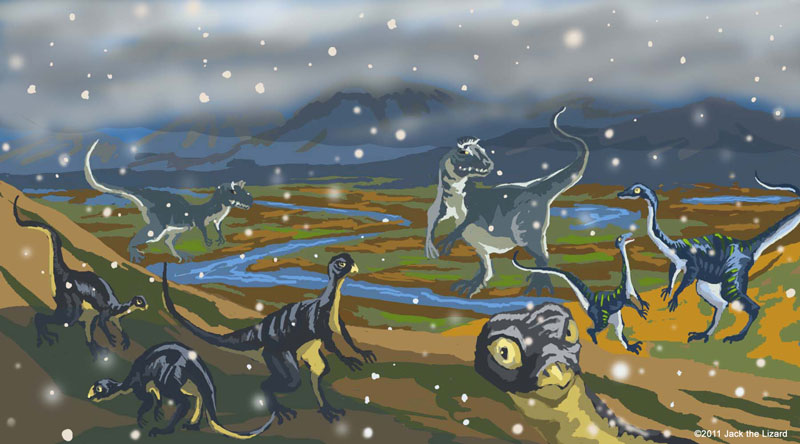
|
|
|
During the Early Cretaceous period about 100 million years ago Australia and Antarctica just came apart from each other. Although Southern Australia was still within the Antarctic Circle then, the climate was much milder than now. Dinosaur Cove in Victoria, southeast Australia yields several dinosaur fossils such as Leaellynasaura and Timimus. When these dinosaurs were alive, the flood plain stretched out there.
The weather in Dinosaur Cove was probably warm; nevertheless snow had covered ground during the winter. From analyzing its eye sockets Leaellynasaura seemed to have very large eyes to have clear vision even in the long dark winter. Leaellynasaura probably stayed active during the winter and had eaten some vegetation. On the other hand Timimus could have hibernated because its bones have sign of hibernation period. The bones of Allosaurus family were also found in Dinosaur Cove. In the middle of frigid blast the kin of Allosaurus could have prey upon those dinosaurs. |
Chewing Dino - Iguanodon -
|
Hinged upper jaw provided huge advantage to Iguanodon. This means that Iguanodon was able to chew. Iguanodon could grind vegetation between upper and lower teeth. Chewing made Iguanodon to digest food more easily. Iguanodon lived during the early cretaceous period, from about 130 to 120 million years ago. The weight was about 3.5tons and the length was about 10m (33ft). Iguanodon was massive dinosaur of its time. One of the unique features of Iguanodon is a thumb spike which could have been used as a weapon against predator or other Iguanodon. The predator which Iguanodon could have been encountered were Aristosuchus, Eotyrannus, Deinonychus and Neovenator. 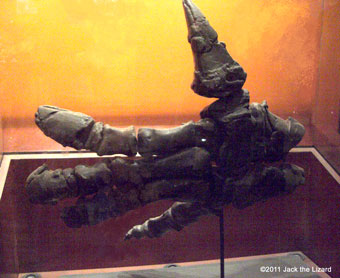
The hand of Iguanodon from Natural History Museum London |
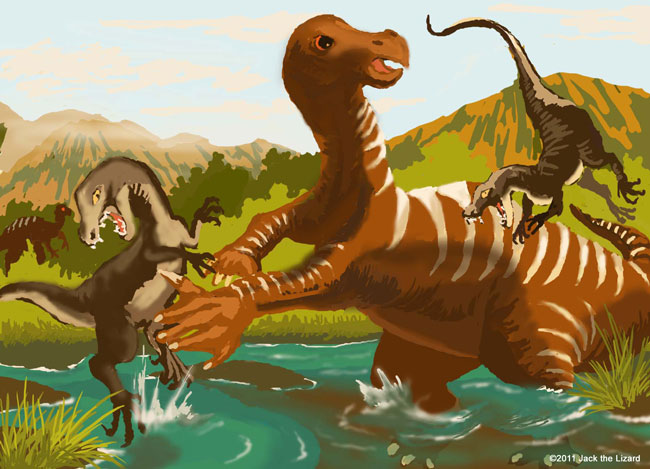
|
Mother of 4,000 mammals - Eomaia -
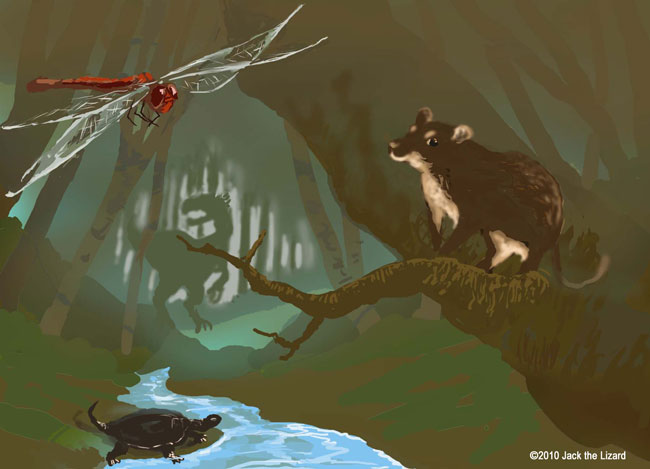
|
Eomaia related to all living placental and extinct mammals. The fossil is found in Liaoning, northeastern province of China. Since it is well preserved, tiny bones and even fur can be observed from it. Eomaia lived in about 125 million years ago. It was about 10 cm (4 in) long and probably ate insects. 
Jack the Lizard There are about 5,400 species of living mammals now. Those mammals are divided into three categories; monotremes, marsupials and placentals. Monotremes such as platypus lay eggs. Marsupials such as kangaroos and placentals such as human bear live young. Placental mammals are the most diversified species among them, about 4,000 species are identified. |
No amphibian No reptile - Diadectes -
|
Diadectes is in the early amniotes family. The amniotes are four-footed terrestrial animals with land adapted hard shell eggs. Although Diadectes looks like reptiles, it has also similar features of amphibians. So it is exactly neither reptiles nor amphibians. Diadectes lived during the early Permian period about 280 million years ago. At any rate Diadectes was probably one of the earliest four limb animals eating plants. The size is about 3m (10ft) long and 100kg (220 lb) in weight. So Diadectes was one of the largest land animals in those days. It had molarlike teeth and large organs to digest fiber-rich plants. 
Jack the Lizard Despite its massive body, Diadectes might be the prey of Dimetrodon. The fossils of Diadectes are found throughout North America, especially in the Red Beds of North Texas. Not many remains of Diadectes are found so far, whereas the fossils of Dimetrodon are discovered many. |
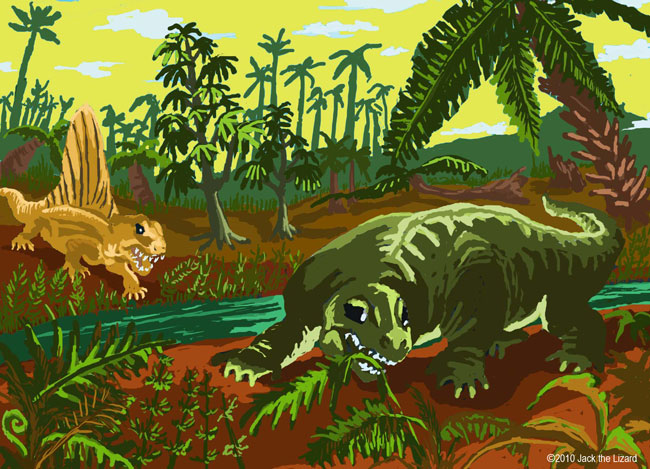
|
Aussie Hunter in Cretaceous - Australovenator -
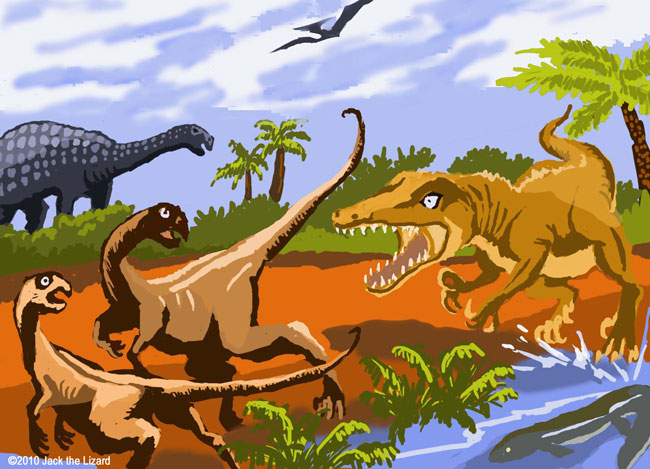
|
Australovenator is the first large carnivorous dinosaur ever found in Australia. The fossils were discovered in the Winton Formation located in north east Australia. Australovenator is the Allosauroid dinosaur lived in the Early Cretaceous period. The height is probably about 2m (6.6ft) and the length is approximately 6m (20ft). It was not mega predator like Tyrannosaurs but perhaps a light weight swift hunter. So the medium size dinosaur like Hypsilophodonts might be the prey for Australovenator. 
Jack the Lizard The fossils of other species are also found from the Winton Formation, such as Diamantinasaurus which is long-neck saurischian dinosaurs, pterosaurs, crocodilians, turtles, lungfish and some plants. |
Colossal tooth - Megalodon -
|
This is Megalodon, not great white shark. Megalodon was cruising in warm water of worldwide ocean from 20 to 1.5million years ago. The size is about 60ft (18m) long and the tooth is 7in (18cm) in length. Probably this gigantic predator did not have natural enemies except own species. The prey of Megalodon included sperm whales, bowhead whales, sea cows and also giant sea turtles. Unfortunately or fortunately for prey Megalodon became extinct. Luck of food or the climate change and the other factors are considered as the cause of extinction. Megalodon was super fish, but nobody claim the victory against Mother Nature. 
Jack the Lizard Megalodon movie is here. |
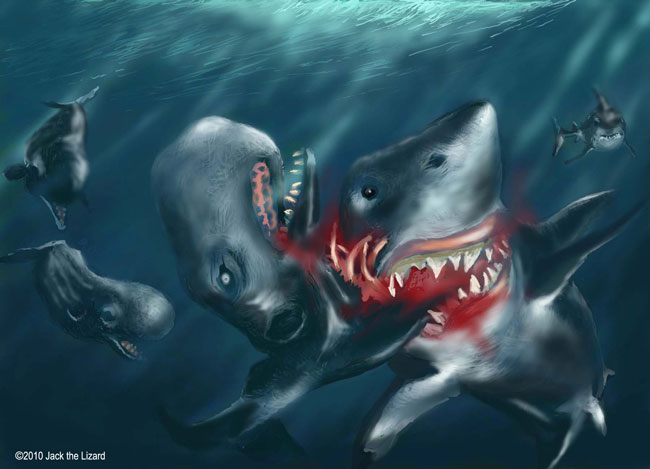
|
Santana formation - Angaturama -

|
Santana formation in Brazil is the stratum in which various kinds and well preserved fossils are found. This layer which formed in early cretaceous period includes fossils of fish, amphibians, reptiles and dinosaurs. 
Jack the Lizard Angaturama is a kind of Spinosaurus family. The size is about 8m (27ft) in length and 2 tons in weight. Probably fish is the main prey of Angaturama. Santana formation also includes several kinds of pterosaurs such as Tapejara, Anhanguera and Tharassodromeus. Especially head of Tharassodromeus is one of the significant discoveries because of the imprints which are probably veins on the crest. Tharassodoromeus could have regulated their body temperature with those veins. Santana formation is famous for the richness of fish fossils too. Calamopleurus had scales and long body, which is about 140cm (56in) in length. Iansan is a kind of ray, which is about 50cm (20in) long. Santana formation movie is here. |
Dinosaurs in Texas - Acrocanthosaurus and Paluxysaurus -
|
Acrocanthosaurus lived in North America during early cretaceous period, about 125 to 100 million years ago. The fossils were found in Oklahoma and Texas. This dino was probably the largest carnivorous dino of its time. Acrocanthosaurus could grow up to approximately 12 m (40 ft) in length and weigh about 7 tons. It is related to Giganotosaurus or Allosaurus. The feature of Acrocanthosaurus is the high spine which is similar to the one of Spinosaurus, but only lower. The function of this spine is still unknown. 
Jack the Lizard Paluxysaurus got its name in 2007. This dino is probably related to Brachiosaurus and plant-eater. The size is about 60 ft in length and 22 tons in weight. Paluxysaurus lived around 110 million years ago. The fossils were from the Twin Mountains Formation in Texas which also included the remains of Acrocanthosaurus. Deinonychus was also living about 119 to 105 million years ago. The fossils were found in Montana, Wyoming, Oklahoma and Texas. Deinonychus might have to wait Acrocanthosaurus to finish eating. Acrocanthosaurus and Paluxysaurus Movie is here. |

|
Dino size lizard – Megalania -
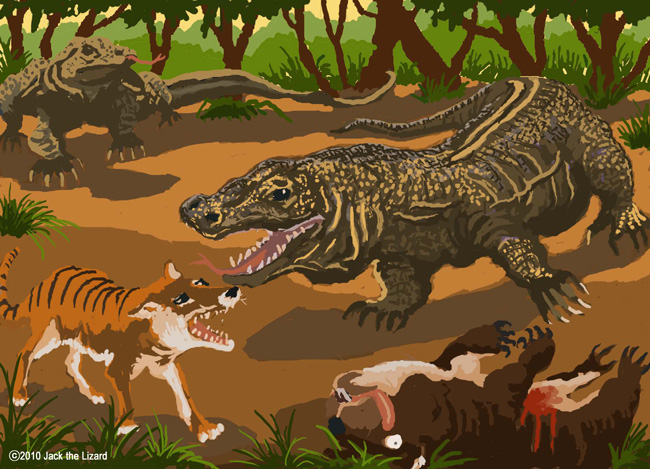
|
Megalania lived in Australia during the Pleistocene epoch from 1.8 million to 10,000 years ago. This giant monitor lizard was probably 5~7 m (15~23 ft) in length and weighed as much as 600 kg (1300 lb). 
Jack the Lizard Megalania might have venom to hunt as modern-day Komodo dragon does. The prey was probably included Diprodon which was giant wombat, about 3 m (10 ft) long. Thylacine(Tasmanian Tiger)might have encountered Megalania. But thylacine was only about 1.5 m long, so it could be fallen into the victim of Megalania. |
Frog like crocodile Mastodonsaurus
|
Mastodonsaurus is a prehistoric amphibian called temnospondyli. They lived about 215 million years ago during Triassic period. The size is about 4~5 m (13~16.4 ft) in length. A remarkable feature of Mastodonsaurus is the large triangle head about 1.25 m (4.9 ft). The habitats were swamps, ponds and rivers. They were predators and probably hunt mainly fish. The fossils are found in Europe. 
Jack the Lizard Thecodontosaurus lived about same period as Mastodonsaurus did. The size was about 1~1.25 m (4 ft). Kuehneosaurus was about 70 cm (2.3 ft). They looked like lizards with wings. The wings formed from extended ribs. Both of the fossils are found in England. |
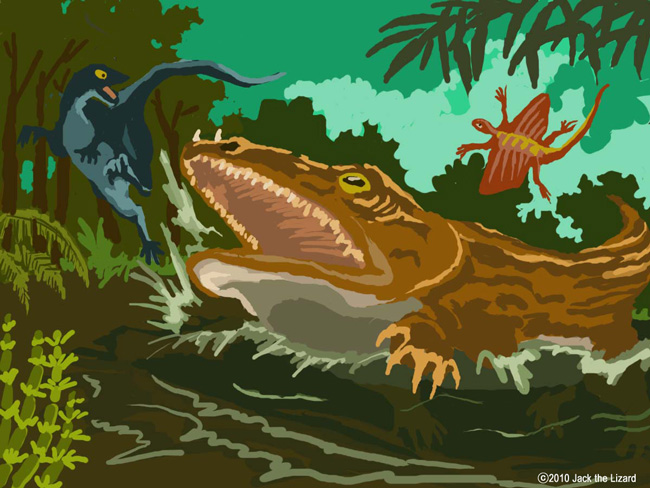
|
The life of Allosaurs
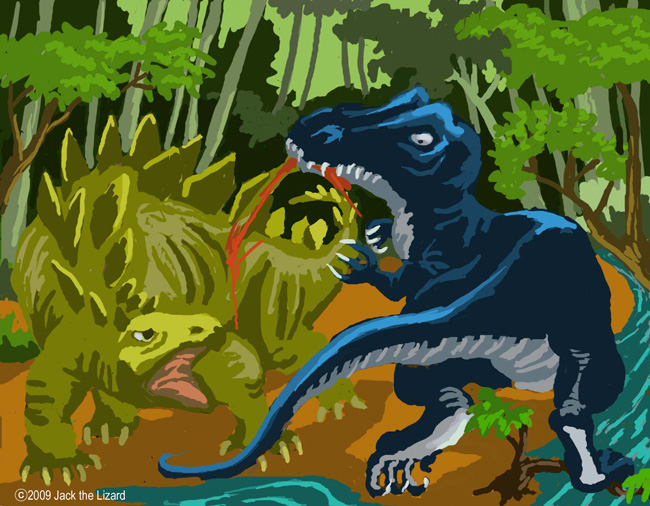
|
Allosaurs had tough life. The fossils revealed that they had broken tails, ribs, jaws and infection. Probably these injuries came from hunting or fighting against each other. The fossils also tell that they recovered and live long after. They surely were tough dinosaurs. 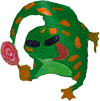
Jack the Lizard Since the mark of the tail wound matched Stegosaurus tail spike, Allosaurs might attack a Stegosaurus. Also the back bone of Apatosaurus had bite mark of Allosaurus. The teeth of Allosaurs fell off, but the teeth grew back continuously. Allosaurs might slash the preys' meat with their blade shaped teeth. |
In 2006 Mapusaurus emerged
|
The fossils of the new dinosaur had been unearthed from 1997 to 2001 in South Argentina. In 2006 the new dinosaur was named as Mapusaurus. The place is known as the bone bed in which at least 7 individual Mapusaurus from a juvenile to an adult have been excavated. This may suggest that Mapusaurus lived in a pack and hunt together. It is rare to find a large carnivore bone bed. Up to now only 3 more bone beds, an Allosaurus bone bed in Utah, an Albertosaurus bone bed in Alberta, Canada and a Daspelatosaurus bone bed in Montana, were found. 
Jack the Lizard Mapusaurus was a large carnivorous dinosaur, about 13m (42ft) long, which lived approximately 90 to 100 million years ago during the late cretaceous period. Mapusaurus is as large as Tyrannosaurus but lighter and had blade-shaped teeth to slice meat instead of crush bones with round-shaped teeth. |
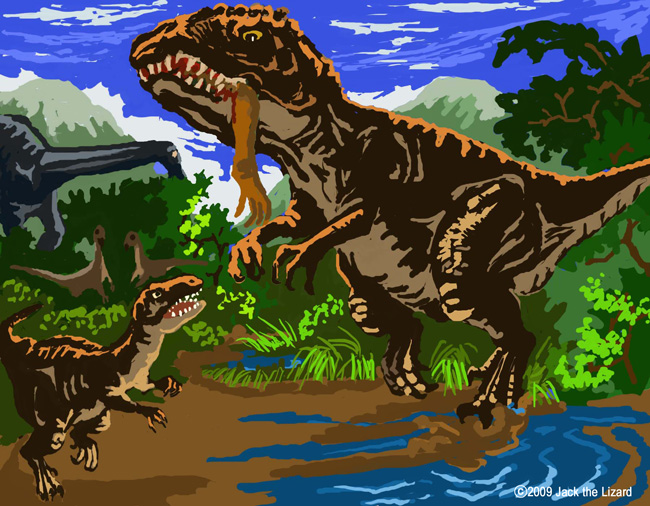
|
The Armadillo stronger than predator - Doedicurus
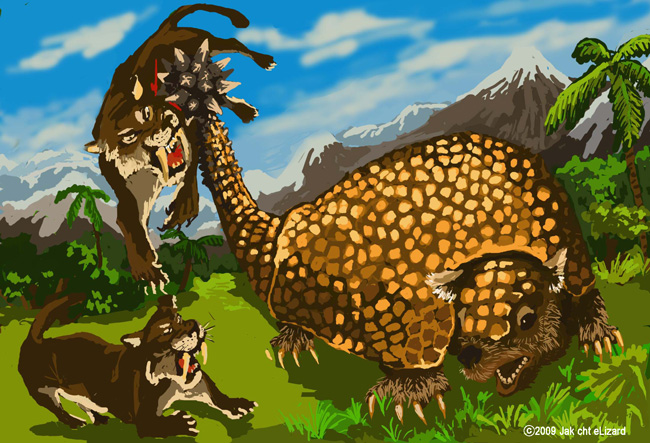
|
The family of Glyptodont (Glyptodontidae) appeared and lived exclusively in South America. The oldest fossils of Glyptodonts are about 47 million years old. When the Isthmus of Panama linked South America to North America about 3 million years ago, Some Glyptodonts moved into the southern United States. It is imaginable that Glyptodonts are relative of armadillos, but they are also related to anteaters and sloths. 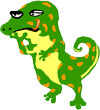
Jack the Lizard Doedicurus is one of the largest species in this family. They are about 4 m (13 ft) long and a ton in weight. About 2 million years ago they had emerged and lived until the end of the last ice age, around 11,000 years ago. Since they were herbivores, they inhabited in woodlands and grasslands. |
The Fish Period - Dunkleosteus
|
Dunkleosteus was the biggest predators in the ocean at the Late Devonian period, which is about 360 million years ago. The gigantic armored fish, up to 10 m (33 ft) long, was the meat eater and ate anything such as mollusk and fish. The biting was as powerful as Tyrannosaur's. Unlike sharks, they do not have teeth. In stead of teeth the sharp front blades were developed from the jaw. The fossils were found all over the world like the USA, Morocco, Belgium, Poland and so on. Cladoselache was the shark, who shared the ocean with Dunkleosteus at the same period. The 1.8 m (6 ft) long fossil was found in the USA. The body structure told that the Cladoselache could swim fast and was similar to the one from the current Lamnidae family such as the great white shark and the shortfin mako shark. But unlike them having their mouths on the bottom of the heads, cladoselache had the mouth on the front side of the rounded snout. Dunkleosteus and Coccosteus were the Placodermi. They were armored prehistoric fish. Coccosteus was about 40 cm (16 in) long and swam on the bottom of the ocean. The fossils were discovered in the USA, UK, Russia and so on. National Museum of Nature and Science in Tokyo, Japan has displayed the real fossil specimen of Coccosteus. Gemuendina stuertzi was also one of the Placodermi. It lived in the Early Devonian period, around 370 million years ago. The fossil was found in Germany. It was about 30 cm (12 in)long and looked like ray. Similar shaped fossils were discovered in the USA, Bolivia in South America, Morocco in Africa and so on. Unlike the current ray, Gemuendina's mouth opened on the upper side of the flat head. They possibly ate the animals living on the bottom of ocean such as sea urchins and shellfish. |
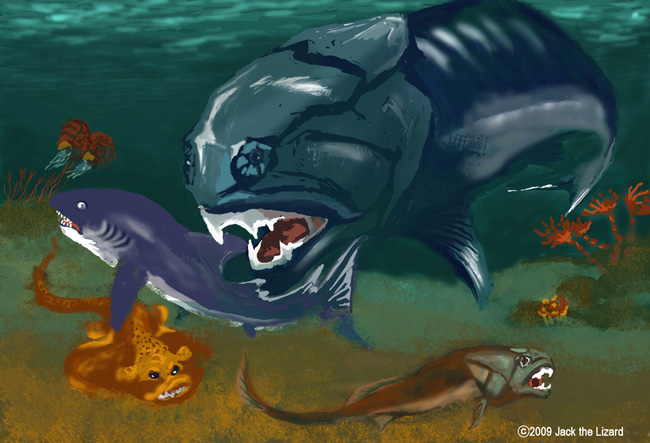

|
The Saber group
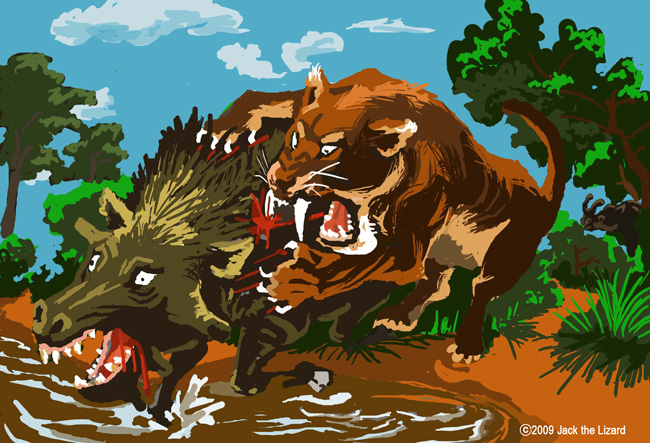
The coloring page of Smilodon is HERE! |
There are three types of saber-toothed cat, Nimravidae, Barbourofelidae and Machairodontinae. The oldest family is Nimravidae. Hoplophoneus is the most known of this kind. The body is about 3.5 ft (1.1 m) long. About a small size leopard but Hoplophoneus had strong muscular body with short legs. The feature is the lower jaw which has the pockets for long fangs. They had appeared about 38 million years ago in North America and disappeared about 4.8 million years ago. Barbourofelis morrisi lived in North America about 10 million years ago. The size is about a lion, but the legs were shorter and body was more massive. They probably had ambushed preys. The oldest kinds of Barbourofidae appeared around 16.9 million years ago in Africa and spread from there to Europe, Eurasia, Asia and North America. Barbourofidae died out about 7 million years ago. Machairodontinae is the closest family of modern cat family among three. Famous Smilodons belong to this family. They had lived in North America from about 1.8 million to 10000 years ago. The length is about 2 m and the fangs are about 11 in (28 cm). Entelodonts lived in North America, Europe and Asia from about 37 to 16 million years ago. They look like pigs, but they are not closely related. They ate both plant and meat. The size is up to 7 ft (2 m). Although they had sharp tusks and heavily build body, they probably had been hunted by Hoplophoneus. |
The dawn of Triassic dinosaurs
|
The fossil of Herrerasaurus was found in Argentina, so it probably lived around there. But one big supercontinent "Pangaea" was existed during the Paleozoic and the Mezonic eras. Herrerasurus lived during late Triassic period which was the first period of Mezonic era. So Herrerasaurus could be found somewhere else. The size was about 3 ~ 4m (10~13ft) long. Diet was probably meat because of serrated teeth.
Postosuchus is not dinosaurs. It is relative of crocodiles. The fossils were found in Arizona and Texas. Postosuchus was formidable predator which was about 5m (16ft) long and had a huge head like Tyrannosaurus. The teeth were long about 8cm and serrated. From its structure of body Postosuchus could run fast and might stand on two legs. Even dinosaurs were prey of Postosuchus. |
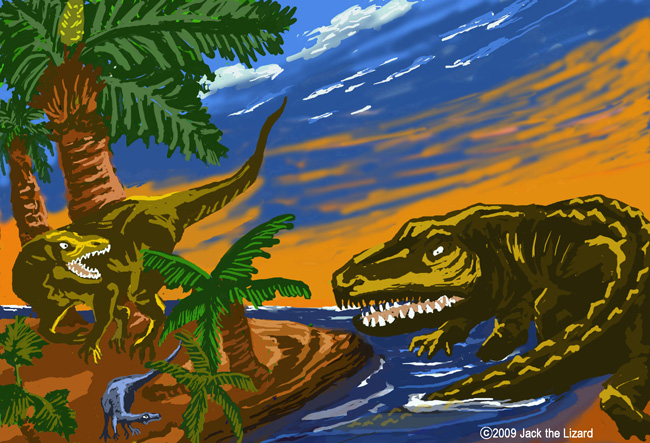
|
Mollusks are survivor
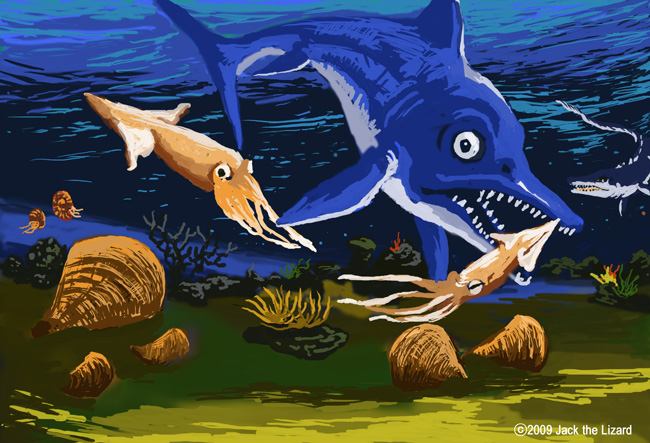
|
Inoceramus lived during the Cretaceous period. Once they could be found all over the world, but they are now extinct. The form of Inoceramus is similar to the oyster or the clam and composed of two-part shells. Small one is a hand size but large one is a human size.
Both Belemnites and Inoceramus are Mollusks. So many animals still depend on the family of Mollusks. They are truly super creature. |
Purple Frog
|
Purple frogs live in the Western Ghats India. They usually stay underground except the monsoon season. During this rainy period from June to September, they emerge from the earth to mate. The Seychelles frogs only inhabit Seychelles Islands. Purple frogs belong to the family of the Sooglossidae to which the Seychelles frogs also belong. The origin of Sooglossidae can trace back to the age of Gondwana about 130 million years ago. So Purple frogs are living fossils. 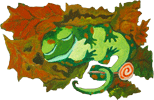
Gondwana was the continent included India, Seychelles Islands and Madagascar. The Late Cretaceous period abelisaurid dinosaurs roamed around Gondwana. Indosuchus, means Indian crocodile, is one of those. Majungasaurus is also in the same family and lived in Majunga Basin, Madagascar about same period. |
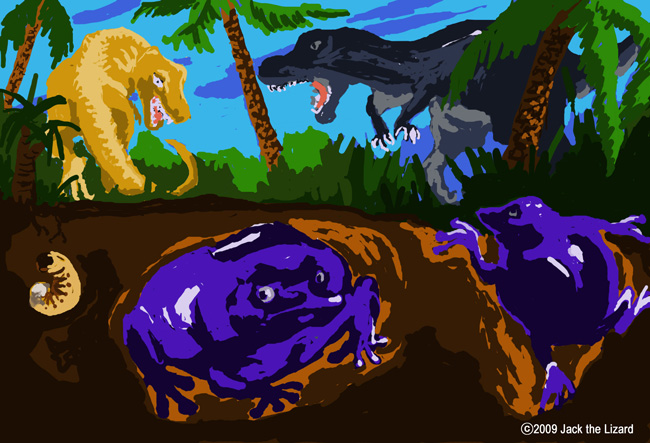
|
Spinosaurus
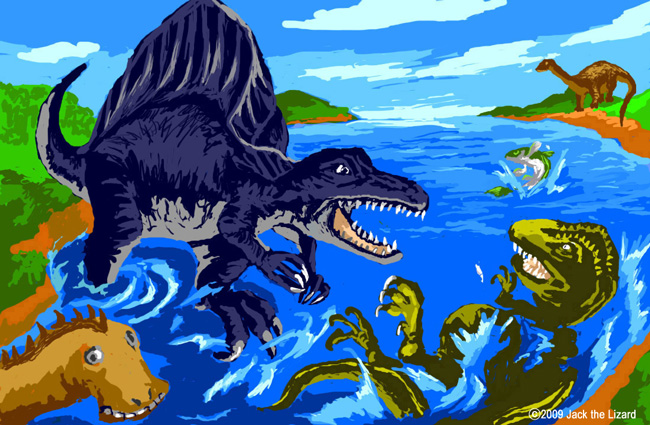
|
Spinosaurus lived in North Africa. Irritator whose fossils were found in Brazil is closely related to Spinosaurus. Both of them have similar upper front teeth and the sail on their back. Baryonyx and Suchomimus also have physical resemblance of which they have huge claws on their thumbs. All four dinosaurs are in the family of Spinosauridae.
Spinosaurus Movie is here. |
Predator in the sea
|
Although Cretoxyrhina was a formidable predator, it was also eaten by the largest mosasaurs called "Tylosaurus". Tylosaurus could grow up to 15m (49ft) long. The pointed snout could thrust prey. The fossil of Tylosaurus can be seen at the University of Kansas Museum of Natural history. |
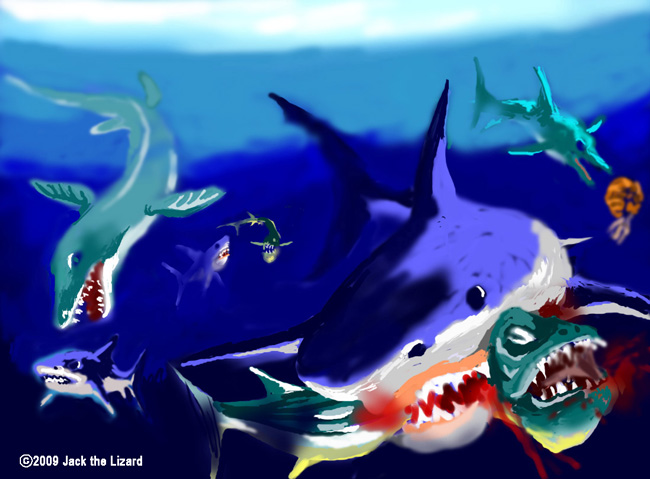
|
Enigmatic Big Claws
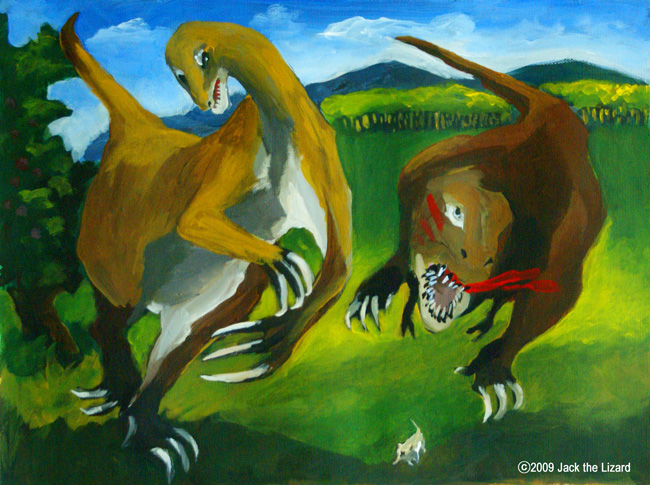
|
The claw of Therizinosaurus is about 90cm (36inch) long. It is huge, compared to the size of the body about 11m (36ft) in length and 6tons in weight. The first fossil of Therizinosaurus was found in Mongolia. Therizinosaurus probably lived in Asia during late cretaceous period. Several dinosaurs are in the family of Therizinosaurus includes Erlikosaurusu, Segnosaurus and Nanshiungosaurus. All of them are plant eaters. Their fossils were found in Mongolia and China. There is a North American Therizinosaurus which is called Nothronychus whose fossils were discovered in New Mexico. Tarbosaurus is about same size of Therizinosaurus. The claw could be used as a defensive weapon against carnivorous dinosaur like Tarbosaurus. By the way lifespan of Tarbosaurus could be 25 to 28 years. In contrast big herbivorous dinosaurs could live up to 100 years. 
|
Mammals ate Dinosaurs!?
|
Repenomamus giganticus was a mammal. It might resemble Tasmanian devil in appearance. Their fossil is about 130 million years old, found in the Liaoning province of China. Repenomamus robustus is 50 cm in length about half size of giganticus. It was considerably a large mammal in this era. Despite its body size, it ate dinosaurs. Its stomach contained the skeleton of juvenile Psittacosaurus which was an herbivorous dinosaur.
|
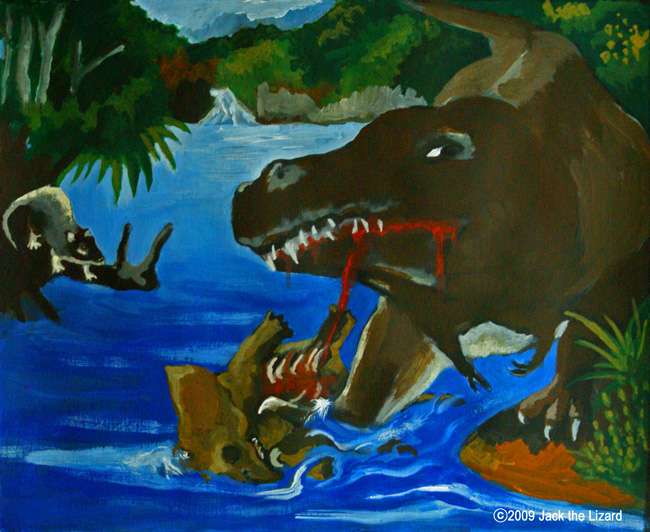
|
Grey hound Croc
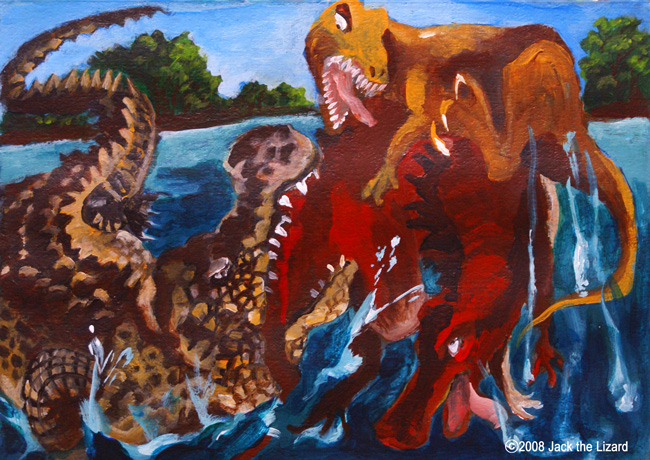
|
So called "Super Croc" Sarcosuchus was 12m long, 10 tonnes in weight. It looks like that the greyhound bus with big teeth was charging Ouranosaurus.
A number of fossils of fish and turtles have been also unearthed with those dinosaurs. It could be very warm and there were lakes, rivers and tropical forest around that region in the Cretaceous period. 
|
Fish, what a great being is!
|
Fish is very important for other animals. They sustain other life by being eaten. As long as concern of visibility, we can actually see huge quantity of fish is eaten by itself, mammals, human, and etc. Baryonyx that lived in England around 125 million years ago mainly ate fish. They had distinguished claws, which was probably used to hook fish out of water and their teeth were serrated to seize slimy fish. Oldest fossilized fish is probably Arandaspis, which is about 500 million years old. Arandaspis had suckers instead of jaws like modern lamprey eel does. By the way Italian ate fried eel, which called in Italian “anguilla” especially in Naples. Japanese also like grilled eel not sashimi though, but number of wild eel is decreased and very expensive now. |
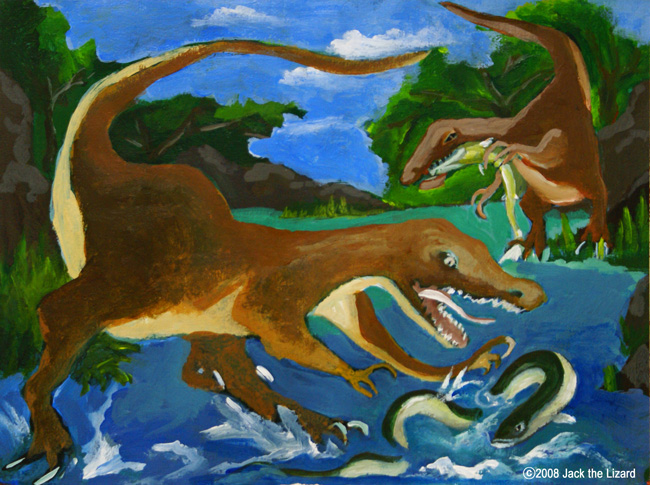
|
Three survivors
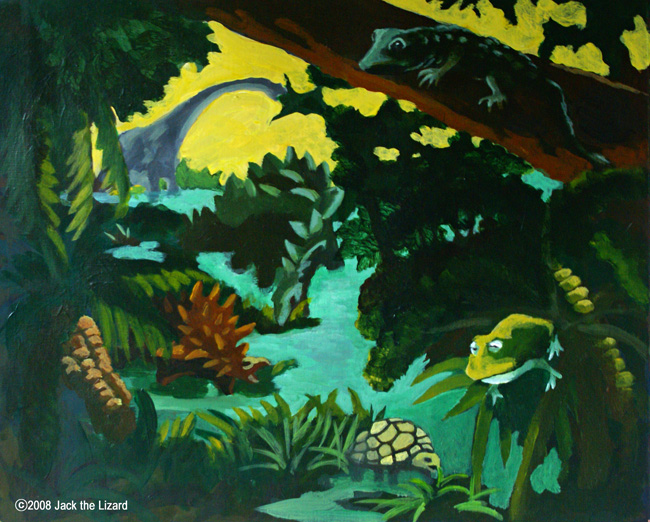
|
Odontochelys that lived in China 220 million years ago is known as the oldest turtle ever discovered so far. Unfortunately it was extinct, but the other turtles survive and continue to thrive. On the other hand Tuatara that is lizard like creature was also appeared on Earth 220 million years ago and its descendant still live in New Zealand!! Frogs are threatened by epidemic disease now. That already wipes some of species out. Frogs have long history as turtles do. Vieraella is the earliest frog and it lived together with dinosaurs in Jurassic period (about 140 – 220 million years ago). |
The feature is a Tail club
|
Ankylosaurus was a heavily armoured dinosaur of which even head was protected with helmet like bone. From its characteristic mouth inferred Ankylosaurus was an herbivore. But present-day a hippo which is also herbivore can go terribly mad. If Ankylosaurus was threatened, adult one was big and strong, about 11 m long and up to 4 tons in weight, enough to defend by itself from carnivorous dinosaurs. T-rex might get blow from its powerful tail club. Family of Nodosaurus had armoured body but they do not have club tail. Ankylosaurus existed in North America about 65 million years ago. |
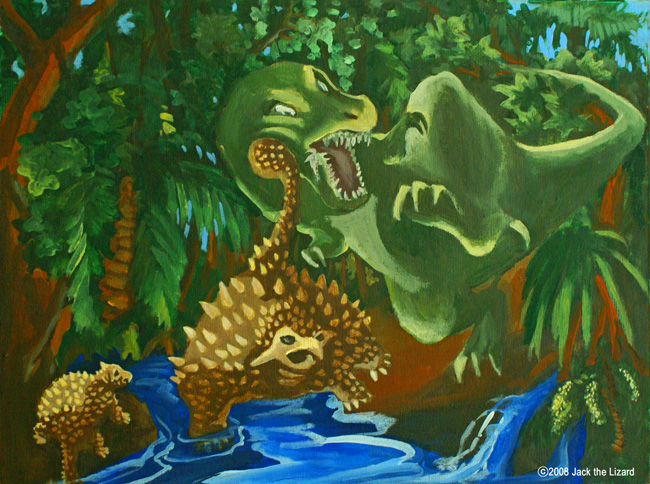
|
Moonlight hunting
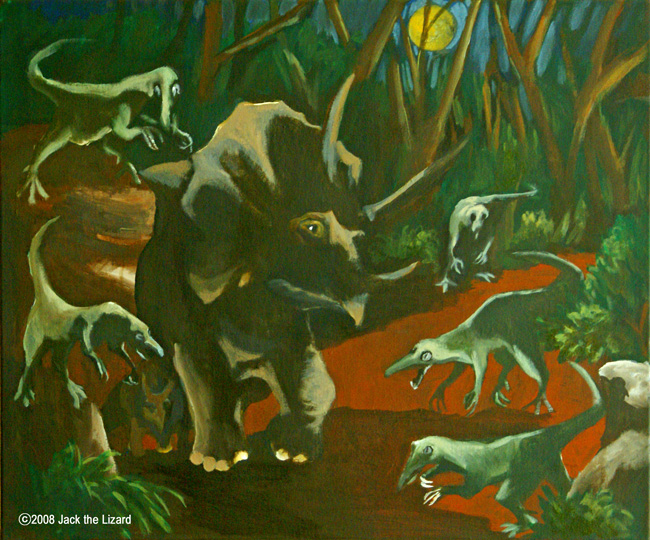
|
Troodon was roaming around North America and Central West Asia about 70 to 65 million years ago. Troodon was a relatively small dinosaur about 2 meters from head to tail, 1 meter tall. The brain of Troodon was very large relative to its body mass. With its big forward facing eyes, Troodon might have had good depth perception and night vision like today’s bushbaby. Troodon had a sharp head and light slender body, so it could probably quickly maneuver itself within bush forest. On the other hand, Triceratops had heavy solid frill with big horns. Those were very good defensive equipments against large predators like T.rex. Full-grown Triceratops was about 9 meter long in length, 3 meter tall and weight up to 6 to 12 tons. Based on fossilized footprint, Triceratops walked slowly with its 4 short legs. After nightfall, the team Troodon had an advantage. |
Oceanic champion of all time
|
Liopleurodon was a huge marine predator whose fossil was found in Europe and Central America. Liopleurodon had massive body, which was at least 25 meters long, yet it was able to swim very fast with its fins. Liopleurodon also had quite keen sent to hunt its pray. Sharks have had their ancestors since 409 million years ago. Modern sharks do not have natural enemies except their own species but they were easy snacks for Liopleurodon 160 to 150 million years ago. Probably Liopleurodon was on the top of the food chain at that time. By the way, the oldest fossilized crab was found in Rumania. It was 150 million years old. The ammonite also had long history itself. It lived 400 to 60 million years ago around the world. Nowadays, the nautilus has the vestige of the ammonite. |
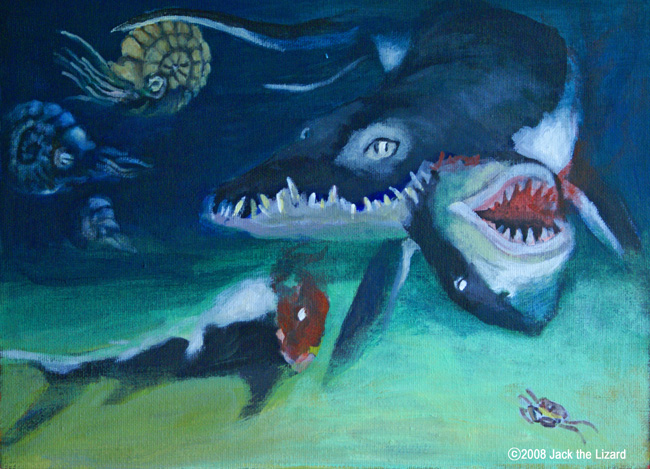
|
T.rex in Action!

|
It was not certain whether the Parasaurolophus was killed by the Tyrannosaurus or not. Ceratosaurus lived during the Jurassic period (203 – 135 million years ago) in North America. The body size of relatives of Ceratosaurus was 4.5 to 6 meters long, so it was no much to the Tyrannosaurus which grew up to 12 meters long. Although Tyrannosaurus had huge powerful jaws with big sharp teeth, they swallow meat without chewing. By doing so led them into trouble. One fossil shows that a relative of Tyrannosaurus was choked to death because two bones were stuck in its throat. Tyrannosaurus lived in North America during the Cretaceous period (135 – 65 million years ago). Some of relatives also lived in China. |
Catch me if you can.
|
The fossil of Xiphactinus, which lived 87-65 million years ago, was found in North America. Despite it's size, which was up to 6 meters long, Xiphactinus could swim very fast to hunt fish, sea birds, and even Pterosaurs. It was possible that this formidable killer fish could jump well above sea surface to catch their prays like the Great White Shark does in modern days. Pteranodon was probably flying all over the world. Although Pteranodon had long wing span, which was reached 9 meters long, was very light weight about 20 kg. Pteranodon was gliding over lakes, river mouth or sea coast to catch fish. Alien like crests were probably being used to attract females. "It was so close!!" he said. |
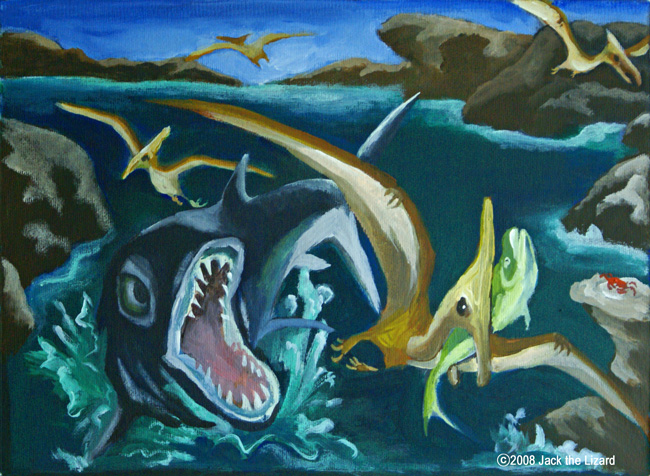
|

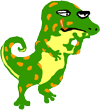



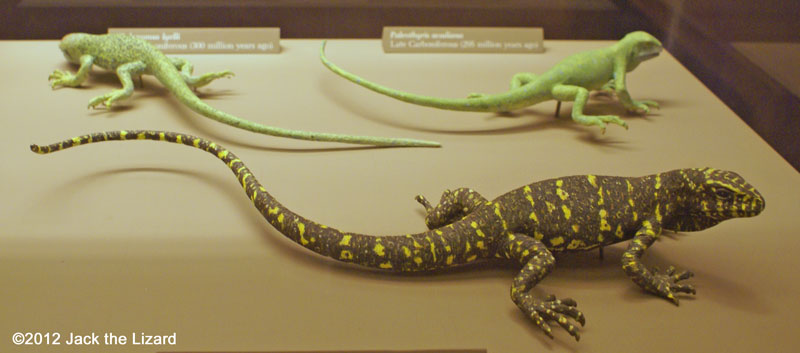


 Cretoxyrhina mantelli was a big shark which is about 7m (24ft) long. In late cretaceous period there was sea which runs through continental North America called “Western Interior Seaway”. Cretoxyrhina lived in this sea about 100 million years ago. The Prey of Cretoxyrhina could be small type of mosasaurs, plesiosaurs and even large predaceous fish Xiphactinus.
Cretoxyrhina mantelli was a big shark which is about 7m (24ft) long. In late cretaceous period there was sea which runs through continental North America called “Western Interior Seaway”. Cretoxyrhina lived in this sea about 100 million years ago. The Prey of Cretoxyrhina could be small type of mosasaurs, plesiosaurs and even large predaceous fish Xiphactinus. Tarbosaurs was an Asian T-Rex about 70 million years ago. Fossils were found in China and Mongolia. As consequence of eating meat, the encounter might happen between Repenomamus and the ancestor of Tarbosaurs.
Tarbosaurs was an Asian T-Rex about 70 million years ago. Fossils were found in China and Mongolia. As consequence of eating meat, the encounter might happen between Repenomamus and the ancestor of Tarbosaurs.